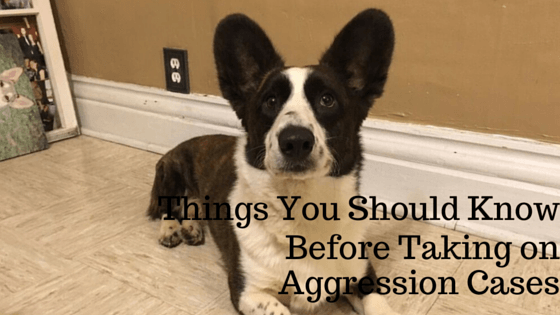
There is no doubt that dog training is dangerous, but you’d be surprised by how many dog trainers are not taking the right precautions when they work with aggression cases. Michael Shikashio, President of the IAABC and outstanding certified dog trainer, hit the nail on the head with his speech at the APDT Conference in Hartford last week. His talk, Staying Safe in Aggression Cases, discussed the following points:
Be Aware Of The Responsibilities Of Aggression Cases
When you take on an aggression case, you’re taking on a lot of responsibilities whether or not you’re aware of them. Consider the liability of handling an aggressive dog. What will your procedure be if the dog bites a family member, another dog, a stranger, or yourself? What are the legal ramifications of such an incident? If you are bitten, you could suffer from physical and psychological injuries as well as a damaged reputation. What will happen to the dog if he bites someone? Are you mentally prepared to handle such a case? Ignoring the possibilities does not make them less likely to occur. You must be prepared for the worst even if you’re expecting the best.
Gather As Much Information As You Can
Michael discussed the usefulness of paper or online questionnaires, but stated that ultimately those cannot compete with an in-person discussion session with the owner. There are non-verbal cues that you can pick up on in person. Speaking with a client in their home makes them more comfortable and you can examine the environment for lesson set ups in the future. Gathering a detailed bite history in person can help you get more information about each incident.
Setting Yourself Up For Success
Michael discussed that there are some simple steps you can take to protect yourself during the first meeting with the dog. Clear written and verbal instructions are a must. Even then, he encourages you to call the owner when you arrive and before you get out of the car to make sure all instructions have been followed. You must assume that the dog will bite if given the opportunity so wear appropriate clothing to the meeting.
Discuss management techniques the owner can put into place such as using two leash attachment points (collar and harness), a waist leash, muzzles, gates, and barriers. He encourages you to demonstrate the proper fitting of all harnesses or collars with the owner on a stuffed animal before the first meeting with the dog.
Back Up Protection
Unfortunately, we know we cannot trust owners to follow instructions 100% of the time or 100% correctly. Accidents happen so have your own personal shield against attacking dogs. Wear secure shoes, avoid loose clothing, and make sure your treat pouch is secure. Bring items like a spray shield for a last resort reaction if you’re attacked. Make sure to remove hats, sunglasses, and scarves before the meeting.
Defensive Handling
One of the most common mistakes trainers make is assuming the dog is alright with them and letting their guard down. Dogs can easily push past their thresholds in order to gain access to treats or food. Luring dogs into your space that aren’t ready to be that close can set yourself up for a bite. Using the treat and retreat game is important, but make sure you toss treats at a good distance behind the dog to keep a safe distance. Also, avoid sudden movements during this game.
Defensive handling is best learned by shadowing an experience trainer, states Michael. Things like leaning away from the dog while training, knowing strong leash grip techniques, and knowing how to use your center of gravity should be practiced well before your first aggression case.
Know Your Options
Ultimately, if you are bitten, you had better know where the nearest emergency room is. Knowing this information before the lesson will make an accident less stressful. You won’t be left wondering where to go or asking your client to look it up for you. It is also not a bad idea to keep a first aid kit in your car for emergencies.
We’d like to give a big THANK YOU to Michael Shikashio for presenting this very important information to trainers at the APDT Conference this year. You can contact Michael for more information at Complete Canines.
Have you started taking on aggression cases? What precautions do you have in place to protect yourself?




Thanks for sharing! Great information!
Thanks for visiting the blog Megan! 🙂